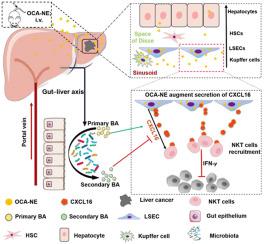Acta Pharmaceutica Sinica B ( IF 14.5 ) Pub Date : 2020-09-15 , DOI: 10.1016/j.apsb.2020.09.004 Guofeng Ji , Lushun Ma , Haochen Yao , Sheng Ma , Xinghui Si , Yalin Wang , Xin Bao , Lili Ma , Fangfang Chen , Chong Ma , Leaf Huang , Xuedong Fang , Wantong Song

|
Primary bile acids were reported to augment secretion of chemokine (C‒X‒C motif) ligand 16 (CXCL16) from liver sinusoidal endothelial cells (LSECs) and trigger natural killer T (NKT) cell-based immunotherapy for liver cancer. However, abundant expression of receptors for primary bile acids across the gastrointestinal tract overwhelms the possibility of using agonists against these receptors for liver cancer control. Taking advantage of the intrinsic property of LSECs in capturing circulating nanoparticles in the circulation, we proposed a strategy using nanoemulsion-loaded obeticholic acid (OCA), a clinically approved selective farnesoid X receptor (FXR) agonist, for precisely manipulating LSECs for triggering NKT cell-mediated liver cancer immunotherapy. The OCA-nanoemulsion (OCA-NE) was prepared via ultrasonic emulsification method, with a diameter of 184 nm and good stability. In vivo biodistribution studies confirmed that the injected OCA-NE mainly accumulated in the liver and especially in LSECs and Kupffer cells. As a result, OCA-NE treatment significantly suppressed hepatic tumor growth in a murine orthotopic H22 tumor model, which performed much better than oral medication of free OCA. Immunologic analysis revealed that the OCA-NE resulted in augmented secretion of CXCL16 and IFN-γ, as well as increased NKT cell populations inside the tumor. Overall, our research provides a new evidence for the antitumor effect of receptors for primary bile acids, and should inspire using nanotechnology for precisely manipulating LSECs for liver cancer therapy
中文翻译:

通过纳米方法精确递送奥贝胆酸,以触发自然杀伤T细胞介导的肝癌免疫治疗
据报道,胆汁酸可增加肝窦内皮细胞(LSECs)趋化因子(C‒X‒C基序)配体16(CXCL16)的分泌,并触发基于自然杀伤性T(NKT)细胞的肝癌免疫疗法。然而,在整个胃肠道中大量的伯胆汁酸受体的表达淹没了使用针对这些受体的激动剂来控制肝癌的可能性。利用LSEC的固有特性来捕获循环中的循环纳米颗粒,我们提出了使用载有纳米乳剂的奥贝胆酸(OCA)(一种经过临床批准的选择性法呢类X受体(FXR)激动剂)的策略,以精确操纵LSEC触发NKT细胞。介导的肝癌免疫治疗。OCA纳米乳液(OCA-NE)通过超声乳化法,直径184 nm,稳定性好。体内生物分布研究证实,注射的OCA-NE主要聚集在肝脏中,尤其是LSEC和Kupffer细胞中。结果,在小鼠原位H22肿瘤模型中,OCA-NE治疗显着抑制了肝肿瘤的生长,其表现要好于游离OCA的口服药物。免疫学分析显示,OCA-NE导致CXCL16和IFN- γ分泌增加,以及肿瘤内NKT细胞数量增加。总体而言,我们的研究为原发性胆汁酸受体的抗肿瘤作用提供了新的证据,并应启发使用纳米技术精确操纵LSEC进行肝癌治疗



























 京公网安备 11010802027423号
京公网安备 11010802027423号